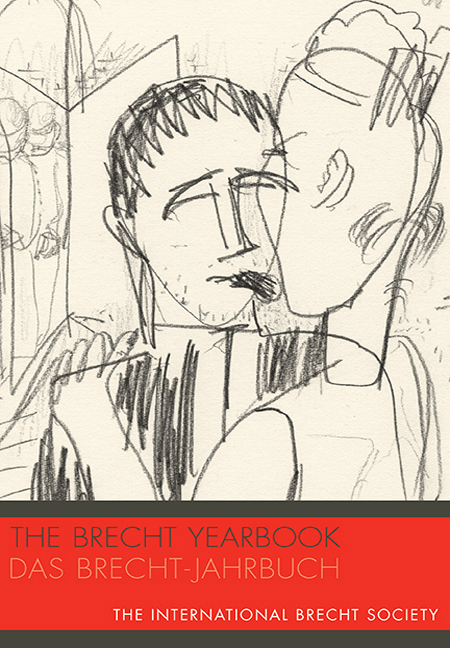Book contents
- Frontmatter
- Contents
- Editorial
- Tribute
- Documents from the Inaugural 24h DURCHEINANDER in Berlin
- Brecht-Images: Artist’s Introduction
- New Brecht Research
- The Temporality of Critique: Bertolt Brecht's Fragment Jae Fleischhacker in Chikago (1924–1929)
- Apparate und Körper: Überlegungen zu Bertolt Brechts Radiolehrstück Der Ozeanflug
- Wer ist Oscar? Ein unveröffentlichter Brief an Brecht vom 12. Juni 1918 aus schottischer Kriegsgefangenschaft
- “leg das buch nicht nieder, der du das liesest, mensch”: Brechts Gedicht “Die Nachtlager”
- Übersehen oder verbannt? Hanns Eislers Bilder aus der Kriegsfibel
- Special Insert: Accompaniments to Brecht, Music, and Culture
- Das “Wiedersehen”: Der chinesische Dichter und Germanist Feng Zhi und Bertolt Brecht
- Brechtian Challenges to Theater Artists during the Internal War in Peru
- “Good Woman should have been done in one of our big theaters long before this”: Brecht, the Students, and the Making of the New Wave of Australian Theater
- Mark Twain's “Magnanimous-Incident” Hero and Bertolt Brecht's Der gute Mensch von Sezuan
- Navid Kermani's Literary Reflections: On Kafka, Brecht, and the Koran
- Karl Kraus und Bertolt Brecht: Über die Vergleichbarkeit des Unvergleichlichen
- Book Reviews
- Notes on the Contributors
“Good Woman should have been done in one of our big theaters long before this”: Brecht, the Students, and the Making of the New Wave of Australian Theater
from New Brecht Research
Published online by Cambridge University Press: 11 March 2017
- Frontmatter
- Contents
- Editorial
- Tribute
- Documents from the Inaugural 24h DURCHEINANDER in Berlin
- Brecht-Images: Artist’s Introduction
- New Brecht Research
- The Temporality of Critique: Bertolt Brecht's Fragment Jae Fleischhacker in Chikago (1924–1929)
- Apparate und Körper: Überlegungen zu Bertolt Brechts Radiolehrstück Der Ozeanflug
- Wer ist Oscar? Ein unveröffentlichter Brief an Brecht vom 12. Juni 1918 aus schottischer Kriegsgefangenschaft
- “leg das buch nicht nieder, der du das liesest, mensch”: Brechts Gedicht “Die Nachtlager”
- Übersehen oder verbannt? Hanns Eislers Bilder aus der Kriegsfibel
- Special Insert: Accompaniments to Brecht, Music, and Culture
- Das “Wiedersehen”: Der chinesische Dichter und Germanist Feng Zhi und Bertolt Brecht
- Brechtian Challenges to Theater Artists during the Internal War in Peru
- “Good Woman should have been done in one of our big theaters long before this”: Brecht, the Students, and the Making of the New Wave of Australian Theater
- Mark Twain's “Magnanimous-Incident” Hero and Bertolt Brecht's Der gute Mensch von Sezuan
- Navid Kermani's Literary Reflections: On Kafka, Brecht, and the Koran
- Karl Kraus und Bertolt Brecht: Über die Vergleichbarkeit des Unvergleichlichen
- Book Reviews
- Notes on the Contributors
Summary
In April 1960, nearly two decades after its first production in Europe, The Good Woman of Setzuan finally had its Australian premiere. It was produced and performed by undergraduates at the University of Sydney, and it was heralded in the Bulletin (an important weekly news journal) as “Sydney's First Brecht.” This first encounter between Brecht's socially and politically progressive theater and the impressionable and enthusiastic young people staging it in the 1960s flags not only an important new stage in the reception of Brecht in Australia and these students’ explicit efforts to challenge the prevailing theater culture of their time, it also lays the groundwork for a significant shift in the Australian theater landscape—the development of the New Wave of Australian theater and drama in the 1970s, a time also when Brecht's work began to be produced frequently by professional companies.
Some background to the social and political context of the day may help explain why it was left to students to be premiering the work of one of the twentieth century's major playwrights in Australia. In 1960 a conservative government, led by Prime Minister Robert Menzies, had been in power in Australia for eleven years and would continue to rule for another, record-breaking, twelve years. Menzies had also been prime minister from 1939 to 1941. In 1940 he banned the Communist Party for security reasons (a ban that was only lifted in late 1942), and in 1949 he campaigned for election on a platform of again banning the Communist Party. His legislation was ultimately struck down by the High Court of Australia as unconstitutional: Undeterred, Menzies took the question to a national referendum where it was again defeated, albeit by the slimmest of margins (50.6 percent to 49.4 percent).
By the end of the first decade of the Cold War, Australia could be seen as a conservative, somewhat fearful, country, and one that also had not completely relinquished its strong colonial ties (which also extended to all things cultural). Australia had become a Commonwealth in 1901, but the official head of state then (as now) was the Queen of England, and until 1948 even Australian-born citizens were considered to be British subjects.
- Type
- Chapter
- Information
- The Brecht Yearbook / Das Brecht-Jahrbuch 40 , pp. 170 - 189Publisher: Boydell & BrewerPrint publication year: 2016



